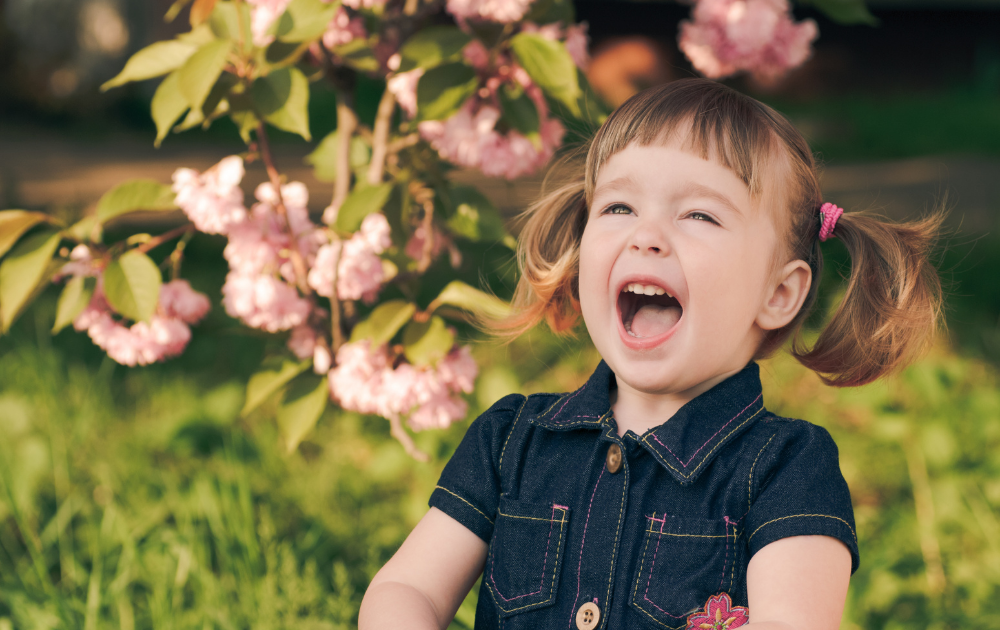
17 Mar Help Your Child Cope With Springtime Allergies: What to Look For and How to Treat Them
Everyone loves the first rush of spring — the glimpse of flowers beginning to bud, warm air blowing through the swings at playgrounds and in parks, and children heading outside without bundling up in layers of woolen scarves and heavy mittens.
But along with the flower blossoms comes something less welcome – pollen and other airborne irritants. If your child has allergies that go into overdrive come early spring, they may feel miserable and not even want to head outdoors.
In this post, we offer suggestions for helping your little one cope with the runny nose, sneezing, and other symptoms of springtime allergies. With a little homemade medicine and a lot of love and care, your child will recover from symptoms of springtime allergies quickly.
Sneezing, sniffling, and watery eyes – those are just a few of the signs your child has springtime allergies. Lots of children feel like they have a cold when allergies set in because the symptoms are so similar. But allergies are manageable if you use these methods to help your child, and of course, add a big dollop of parental love to make the “medicine” go down more easily!
Symptoms of Springtime Allergies:
Here are reactions you’ll notice if your child is allergic to pollen and grasses like goldenrod.
Plenty of sneezing and sniffling. If you’re certain your little one is not reacting to a household pet, like a dog’s or cat’s fur, allergies to plants and pollen may be responsible. Are they congested? Allergies mimic colds and bring on watery eyes, congestion, sneezing, and a runny nose. Depending on where you live in the country, spring allergies can set in as early as the beginning of March – warmth triggers the cycle that causes pollen to bloom.
How To Help:
1. Keep your home’s windows closed.
Everyone loves the scent of a fresh spring breeze. However, it can bring with it many substances that trigger your child’s allergies. Best to keep windows closed, and if the house gets too warm, run your air conditioner.
2. Get a certified filter for your A/C.
There are special filters that substantially reduce allergens in the air. If your A/C system isn’t equipped with one, now’s the time.
3. Be sure their shoes come off at the door.

Once the milder weather is here, children sometimes come indoors still wearing their shoes. Ask them to remove their footwear at the door, so they aren’t tracking in substances to which they might react, like animal fur, pollen, and other allergens. Your floor will be cleaner too – a bonus!
4. Steam helps congestion.
If your little one is all stuffed up, take them into the bathroom and sit with them while running a hot shower, which releases plenty of steam. (Of course, they can take a shower themselves, if they’re old enough). Steam breaks up mucus buildup, and eases breathing. This is great for children with asthma, too.
5. Keep them inside at peak pollen times.

That means playing indoors until just after 10 in the morning, which is when peak activity of allergens begins declining. If they are off to the backyard or heading to the park with their nanny, be certain they wear a hat – even on cloudy days. Keeping their hair free of particles as much as you can will go a long way toward reducing how many allergens cling to them. Dusk is another period during which allergens are more active, so if possible, keep them inside during that time as well.
6. Launder their bedding in hot water.
Even your best efforts to ensure your child doesn’t bring allergens home can only go so far – they’re bound to have something on their clothing and skin. Washing their sheets in hot water helps rid the fabric of substances that get into the bedding and cause more sneezing and sniffling.
7. Change their clothes when they come inside.

This is an excellent way to rid your child of any particles that may be clinging to them. As soon as they come inside, have a clean outfit handy and help them change. Put the “outdoor outfit” straight into the laundry hamper.
8. Bathe your child in the evening.
This helps get rid of anything that might be on their skin or in their hair that causes sneezing and mucus buildup during the night. Shampooing their hair before bed gets rid of anything stuck to it, and is especially helpful for children with long hair.
9. Keep soft tissues handy.
Little noses get irritated easily when they have to be blown constantly. Make the skin under your child’s nose less red and sore by stocking up on tissues that are super soft and contain aloe or lotion. And perhaps keep petroleum jelly close so you can swipe a little on between sneezes.
10. Remind them to keep their hands away from their eyes.
It’s almost instinctive to rub eyes that are watery and itchy. However, that just adds more allergens to their face and will increase the reactions they have to springtime pollen. As much as they can, they need to keep little fingers away from their face and eyes!
Springtime allergies are no fun for children or parents, but they can be made less difficult to handle. They usually last from the beginning of March until the end of June – depending on where you and your family live. If your child’s seasonal allergies appear to be severe or you need more assistance, contact your pediatrician. Once summer arrives, springtime allergies calm down or stop entirely, and your child will be their usual sunny and cheerful self once again!